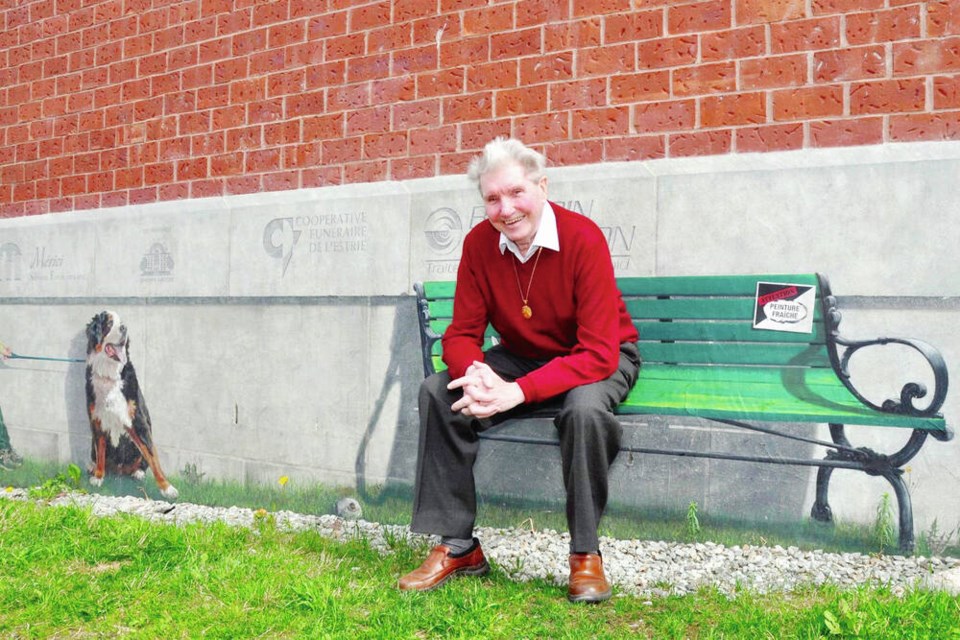The man who championed the world-famous Chemainus murals has died at the age of 92.
Karl Schutz, known for envisioning and initiating a series of outdoor murals in Chemainus in the 1980s, leaves a legacy of visual arts and community dedication, said former mayor Graham Bruce.
“With Karl, if you were going to do it, it had to be done big,” Bruce said. “He was a dreamer.”
Born in Heidelberg, Germany, Schutz was trained as a tool-and-die maker before moving to Canada, where he worked with railway companies and eventually landed in Chemainus in 1952.
In 1971, he was inspired by what he saw during his travels in Eastern Europe with his wife Betty. Schutz returned home and saw more than brick walls and buildings in Chemainus — he saw canvases.
“We saw the monasteries and the beautiful fresco paintings. They had visitors from all of the world and that’s where the idea originated,” Schutz said in a 2013 interview with the Times Colonist.
“I thought, my goodness, what an idea to have a tourism industry in Chemainus.”
The idea was shut down by local politicians at first, but a decade later, Chemainus was facing a great deal of uncertainty.
The town’s sawmill was expected to shut down, and the future of the town was up in the air, said Bruce, who was mayor from 1979 to 1986. Schutz, who had been designated as coordinator for the provincial government’s downtown business improvement funding project, again pushed for the murals.
It wasn’t easy to get approval, Bruce said. Spending roughly $10,000 on Schutz’s “harebrained idea” of an art project was preposterous to many, but Schutz, along with being a champion of the arts, was a convincing and charismatic businessman.
His vision of an art-filled Island town won over the business community, and with it, the will of council. The first mural was painted in 1981, two years before the saw mill closed.
More and more murals were painted in downtown Chemainus and one day, the sawmill returned too. Forest products company MacMillan Bloedel Ltd. was convinced to invest in Chemainus, and the company knocked down the old mill to build a brand new one.
Bruce credits the murals for the town’s revival.
“It was really seen to be a story of another town losing its industry … and then becoming a ghost town,” he said. “And it didn’t. The mill rebuilt.
“I’m sure the murals, the activity, the promotion going on in the community … helped in [MacMillan Bloedel’s] decision between Community A or Community B,” he said.
Today, Chemainus has about 40 murals, most of them depicting real scenes and real people from the area’s history. The murals are recognized worldwide and gave the town its moniker, “The Little Town that Did” after a short film of that name was produced about Schutz’s project. The same title was used for a 1994 article in the Smithsonian — one of countless articles that helped put Chemainus on the map, including a 1992 feature in the Los Angeles Times.
“He leaves a community transformed,” Bruce said. “It could have become a ghost town but didn’t become a ghost town. Many, many people joined together in this endeavour.
“His dreams helped people during a period of time that didn’t look so bright.”
Schutz didn’t stop with Chemainus. He became a consultant and was hired by about 70 municipalities across 61 countries, travelling around the world to help implement community mural projects.
In 1997 he founded the non-profit Global Mural Association, which promotes cultural economic development by hosting conferences and helping cities and towns around the world with mural projects.
In 2014, Schutz passed the Global Mural Association torch to current president Serge Malenfant.
“He was a great soul, he gave so much opportunity to many artists all over the word,” Malenfant said. “He always was very creative, energetic, always on-the-go with new ideas and ways to work out projects.”
Schutz provided the knowledge and business acumen to help artists excel in the world of murals, Malenfant said. He believed in the accessible, unassuming nature of mural art both as a platform for artists and an economic tourism driver for cities around the world.
Murals were a way to share the history, culture and people of a place with pride.
“He was a man of vision,” Malenfant said. “Many artists will be eternally grateful for what he was able to create.”
In 1988, the province appointed Schutz the ambassador of tourism. He received the Award of Excellence from the Federation of Canadian Artists and in 1992 received one of the Queen’s commemorative medals for Canadians who made a special contribution to their community and country.
In 2013 he was named an honorary member emeritus by the Chemainus Festival of Murals Society.
“The murals, they have definitely changed my life,” Schutz said in 2013. “I’m not an artist; I’m an entrepreneur. But from then on, I went into the arts and promoted the arts for all those years.”
— With files from Amy Smart



